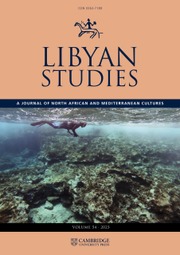This issue of Libyan Studies presents papers from a wide geographical area, covering regions of North Africa beyond Libya; and next year's 50th anniversary issue will include papers from other parts of the Mediterranean that are connected to North Africa. The journal is in fact undergoing a process of transformation to become a more modern, receptive and interdisciplinary forum. This change is motivated by the need for more comparative studies, and the necessity to engage with dialogues between the different parts of North Africa and the western Mediterranean.
The contents of this issue cover different periods, as well as different disciplinary approaches: we have articles based on historical sources or inscriptions, and others that look exclusively at the archaeological evidence or focus on material culture.
The variety of papers, written in English and French, reflect the new nature of the journal and its broader perspective. As usual, there are longer research papers, research notes and fieldwork reports. This issue also contains a larger number of books reviews, from a wide chronological and geographical range, covering modern Tunisia and Algeria, and ancient North Africa – from ritual sites to economic production.
The first two research papers look at the prehistoric period in Cyrenaica and Sudan, providing evidence from two different regional perspectives. The following paper by Andrea Zocchi offers an interdisciplinary perspective on Roman road networks in Tripolitania, making use of inscriptions and integrating them with archaeological evidence. The paper by Keith Swift offers a detailed study of pottery production in the region of Cyrenaica, and presents important new data for a region where pottery circulation and production is generally less well understood than in other areas of North Africa. The Vandal presence in North Africa is discussed by Mohamed-Arbi Nsiri, with a view to questioning previous assumptions. The paper looking at Cyrene addresses the issue of the tombs in the city, now seriously under threat. Finally, Othman Ammar presents his research into the question of sanctity in North Africa. The research notes focus on textual evidence and linguistic analysis. One paper looks at epigraphic evidence and another addresses the Semitic language.
The fieldwork section, which has been severely reduced since the civil war in Libya stopped all major excavations, presents two projects currently running in Tunisia: the excavation of the Circus of Carthage, directed by Hamden Ben Romdhane and Ralf Bockmann, and the work carried out in Bulla Regia under the direction of Moheddine Chaouali and Corisande Fenwick.
The final section presents the annual summary of the Society's activities by the Chair, David Atkinson, and the ‘Notes from Libya’ by the Society's head of mission, Paul Bennett, presents a sometimes horrifying, sometimes encouraging account of the situation on the ground in Libya, and the current situation with regard to the state of Libya's cultural heritage.


